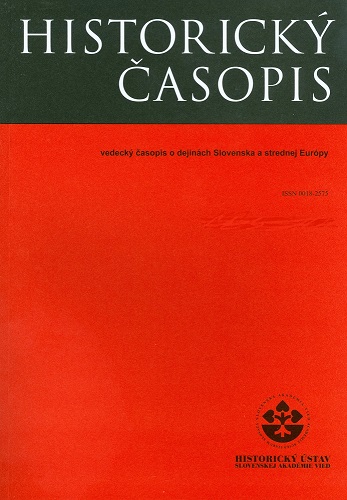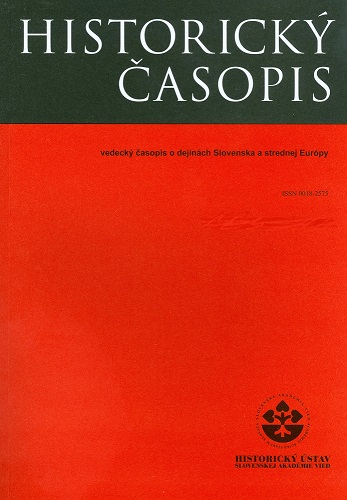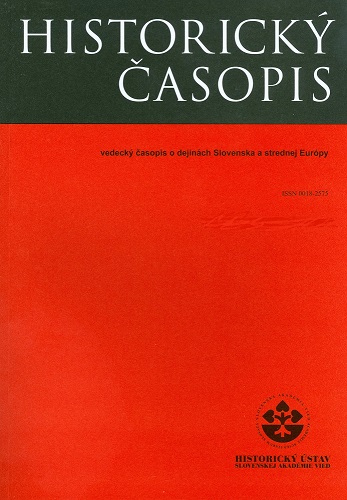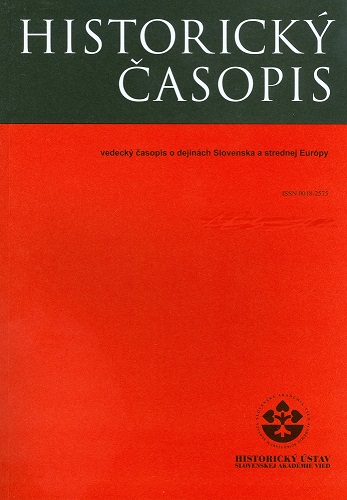
We kindly inform you that, as long as the subject affiliation of our 300.000+ articles is in progress, you might get unsufficient or no results on your third level or second level search. In this case, please broaden your search criteria.




The history of Slovakia and the Slovaks has for many years been perceived in Polish historiography as a component of larger wholes: the history of Hungary or the history of Czechoslovakia. For this reason, Polish historians usually paid little attention to the phenomenon of the national development of the Slovaks in the 19th century. This situation began to change only from the 1990s, when numerous studies finally appeared seeking to see the history of Slovakia and the Slovaks as a separate historical issue from the histories of the Hungarians and especially the Czechs. This text is aimed at presenting the achievements of Polish scholars over the last three decades with regard to the history of Slovakia and the Slovaks in the 19th century. The article describes the most important Polish synthetic studies, collective studies, and finally monographic works on the history of Slovakia and Slovak culture. Attention was also paid to the most important scientific centres in Poland, which initiate research in the field of Slovak culture and history. Despite the growing interest in Poland’s southern neighbour in recent years, significant shortcomings in Polish his- toriography are still visible. The article also attempts to draw attention to the desirable perspectives for further research in Poland.
More...
The study is concerned with the conspiracy against King Matthias Cor-vinus of Hungary in 1471, probably the most serious expression of opposition from the Hungarian nobility against his rule. It is directed towards the course of the rebellion, which was closely connected with a Polish invasion of the Kingdom of Hungary. The core of the paper comprises a description and analysis of the rebellion of part of the Hungarian clergy and nobility led by John Vitéz Archbishop of Esztergom. The paper deals with the causes of the opposition and the motivation of the leading actors, which led to their open rebellion against their monarch, and participation in the subsequent Jagiellonian intervention. It is also concerned with the question of support for the conspiracy in the framework of the nobility and clergy of Hungary, as well as the fate of the representatives of the Hungarian opposition.
More...
Nineteenth century Slovak caricatures come from a wide range of political positions. The magazines Ježibaba supporting the Slovak New School and Rarášek belonging to the Slovak National Party were the most important representatives of political and social humour in the years 1870–1872. They had different approaches to drawing caricatures and their thematic starting points, by which both participated in shaping the political thought of the period. The intense aggressiveness of the drawings in Ježibaba may be seen as a demonstration of the political effort of the New School to establish a new political orientation. On the other hand, the artistically more conservative Rarášek opened social themes and brought systematic effort to the work of political journalism.
More...
The study is devoted to the hitherto little reflected theme of internment in Slovakia in 1919. In the first part, the author describes the situation in southern Slovakia at the beginning of 1919 and the events from the declaration of the state to the end of March that led to the first wave of internment. He also presents the social composition of the people interned in Ilava and the conditions of their life in the camp there. The second part concentrates on internment in May and June, when about 2600 people were taken to Terezín (Theresienstadt). The author also considers the discussions in the public life of the time about conditions in the Terezín camp and about the fact of internment itself.
More...
The article focuses on the elections to the Czechoslovak parliament, which took place in the middle of the crisis year 1935. It tries to answer the main research question: To what extent did the political representation of the different parties differ among themselves and to what extent did the two groups – a) the pro-Czechoslovak and b) anti-system parties – differ? We assume that the pro-Czechoslovak parties (which can also be labelled as establishment parties) will have, on average, older deputies, less regionally distributed, and will come from larger towns on average. Furthermore, we believe that the difference in the representation rate of women or university graduates or the structure of the professions should not play a major role in this respect.
More...
The study uses a wide range of sources to uncover the spread of the ideas of Immanuel Kant outside philosophical circles in the Slovak part of the Kingdom of Hungary. The flow of philosophical ideas is shown not only by the works of Kantians in Hungary, but also by censorship records of the importing of Kantian texts in the 1790s. Critical debate in correspon-dence and in published texts uncovers anti-Kantian arguments. Information about the propagation and multiplication of Kant’s works give an idea of their popularity. Research into memoirs sheds light on how philosophical messages circulated in private communication networks, reaching beyond the philosophical and educational sphere, in spite of bans and repression.
More...
The Prague Spring and its quashing by Soviet tanks was not only an important event in Czech and Slovak national history, it also had a wider, global reach. The events themselves and subsequent occupation of Czecho-slovakia by the combined forces of the Warsaw Pact have not ceased to inspire historical research and public debate. The aim of this essay is not to provide a complete list of works concerning the Prague Spring and the occupation of 1968; the sheer volume of literature on the subject is now overwhelming. Instead, the essay focuses on the most significant works and seek to capture and analyse the main trends in the research into and writing about this event. It focuses on Western historiography – especially works written in English – as that contribution to the scholarship is the most numerous and, arguably, the most influential. It also pays brief attention to the work of German, Italian and French historians.
More...
The author focuses on discriminatory measures against Gypsies/Roma during the Slovak Republic of 1939–1945. She uses mainly the archive collection of the State Archives in Nitra, usable for studying the issue at several levels of public administration (county, district, and local). The content structure of the scientific study follows the IMRAD model and is divided into the introduction, theoretical background, presentation of the most significant research findings and their interpretation in the form of discussion. The main objective of the study is to present a reflective „pause“ over the history of Gypsies/Roma, and their life under the totalitarian regime of 1939–1945 in Slovakia.
More...






The aim of this study is to discuss the role of grandmothers in pre-modern society. It uses results of quantitative testing of the “Grandmother Hypothesis” based on data reconstructed on the Šťáhlavy estate in western Bohemia in 1708–1834 for a qualitative interpretation of this phenomenon. The first part of the paper focuses on the availability of grandmother care and evaluates various aspects of this term. The second issue under discussion is to what extent the potentiality of grandmother care was influenced by the structure of households, which in its turn is closely linked to the socio-economic status of a given family.
More...
By presenting the most recent scholarship on the intense, although not turbulent, relations between Serbia on one side and Czechs and Slovaks on the other, this article aims to show how the unique experience of being on opposite sides during the First World War did not necessarily lead toward creation of animosities and controversies. On the contrary, it not only resulted in support, understanding and cooperationm but also led to the creation of new and deepening of existing liaisons in the decades that followed the first global conflict.
More...
The paper “We Have to Move Forward!” focuses on presenting the organisation and position of the Slovak minority in the Kingdom of Yugoslavia, placing emphasis on the period between the elections for the National Assembly in 1935 and the establishment of the Banat of Croatia in 1939. Special attention was paid to the minority’s viewpoints on the Kingdom’s internal politics, as well as, externally, the conditions in the mother country, that is, Czechoslovakia and Slovakia after the first half of March 1939. The research required the use of archived materials from the Croatian State Archives in Zagreb and the Slovak National Archives in Bratislava, the Slovak minority newspapers, which, among other things, helped reconstruct the zeitgeist, and also the published sources and relevant literature. Although the Slovaks inhabited the entire territory of the Kingdom of Yugoslavia, it is important to mention that the representative area used for this research was the Danube Banat (mostly the area of the present day Vojvodina and Baranja), which was most densely populated by the Slovak minority.
More...